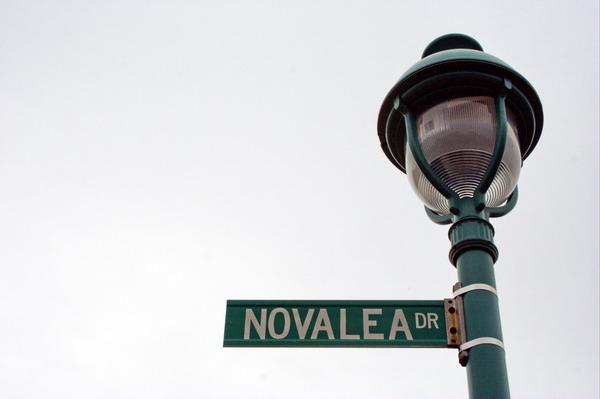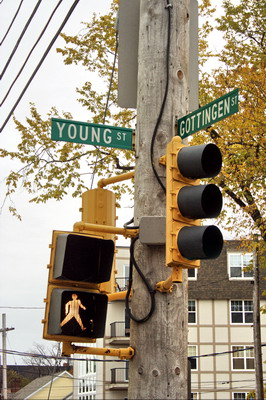
Spaces and faces are much the same – both have names that, when used properly, can get you places. Knowing someone’s name is really half the battle in getting to know them, it gives you a little insight into their character, gets you thinking about what their parents are all about and most importantly allows you to get their attention from far away.
In much the same way, knowing the name of a street is the first step in getting to understand the city you live in. Once you know the name of a street you can call a cab to it, write a letter to it but most importantly you can start musing about who gave it that name and why.
Every Tuesday this past summer I would walk a herd of 4-6 year olds from the George Dixon Centre to the Needham Recreation Centre to go swimming. On this walk I was always puzzled that after the intersection at Young Street, the name of Gottingen Street changed to Novalea Drive. I found this to be a bit bizarre as there is no perceptible change in the road, direction or otherwise. Upon further investigation I have found that these street names share a complex past.
Gottingen is a town in the Lower Saxony region of Germany. It was from this region that many Nova Scotians immigrated around 1750, arriving in the northern suburbs of Halifax. Over time the majority of the German-Haligonian population relocated to Lunenberg County and in 1764 the remaining Halifax contingent petitioned the city to have their thinning German community solidified with a street name.
The street that was named Gottingen in 1764 was a small country road that wound its way up to Fort Needham. With time and further development the early 1900’s saw this small road became a bustling commercial centre at the southern end with residential sprawl to the north. But the Halifax Explosion of 1917 shifted reality on Gottingen. The northern part of the street was essentially destroyed while the southern portion was spared. The rebuilding efforts of the northern section by Thomas Adams led to the creation of the modest, semi-attractive Hydrostone district appealing to the middle and upper classes that emerged after WWII.
In contrast to the improvements being heralded in the northern Hydrostone area, the southern end of Gottingen was in deep decline. A victim of suburbanization and “urban renewal” the population of southern Gottingen street dropped from 13,070 in 1961 to 7584 in 1971 – mostly tenants, with a 58% employment rate.
It was from this ‘deteriorated’ southern portion of Gottingen that I marched with my small friends every week. Most of these friends of mine live in Uniacke Square, the infamous housing project built in 1966 which is home to the realities of racialized poverty. Many of the single parent families living on social assistance in the Square are themselves, or are related to, former residents of Africville who after their forced relocation in the 1960’s experienced a lack of social supports and opportunities leading to increased levels of poverty and violence.

In the late 1970’s the contrast between life north and south of Young Street on Gottingen was stark and the Hydrostonites were not feeling comfortable. They didn’t like that their street name and “their” street name was the same. They wanted to dissociate themselves from the need that lived down the street, so they changed their street.
The residents of the Hydrostone area petitioned the city and won a new name, Novalea; A pretty, fresh sort of name bringing to mind a new meadow drenched in morning dew, free from the history of relocation ripening across the intersection.
Both of these street names were brought into existence by communities that were seeking acknowledgment of their respective realities. As the original German residents watched the numbers of their community dwindle they sought recognition for their history and the place their history had in Halifax. Though anyone walking in “Dutch Town” (as it was previously called) would have known by the food in the shops and the words on the streets this was a German part of town, it was only when the name was given that the true history of this people was made explicit.
Similarly, the difference between the Northern and Southern portions of Gottingen Street was perceived long before the introduction of Novalea Drive, yet the implementation of this name solidified the difference.
photos by Hugh Pouliot

6 comments
Embarrassment with the negative connotation attached to names
is a sentiment that has similarly motivated
the name change of many streets that run throughout
south-Gottingen neighbourhood:
Maynard street changes to Fuller Terrace as it crosses North street,
one block east, Creighton street similarly changes to Northwood Terrace,
and in 2006, the negative reputation of Garrish street
was eliminated in its’ name change to Buddy Daye.
What does this trend suggest about the way we live on,
have pride in, and concern for the streets of our city?
Name changes are not unique to the North End of Halifax.
Pleasant St is now Barrington. Rollenburg was renamed to Clyde St. Paris St is now Almon St. I believe a lot of name changes were political (city of Berlin was renamed to Kitchener in Ontario, during WWI), where as others have been renamed for easier navigation purposes (sections of Tower Rd to Martello, Market St to Albemarle).
Some streets are arbitrarily named, and in those cases I fully support name changes that reflect local heritage.
Thanks for this article. It brings the history of the area to life.
How easy is it to change a street name?
whatever novalea. i live off of gottingen. thank you german immigrants for founding such a rad street.
Interesting history. I lived at the North end of Gottingen St just a stones throw away from the Rock Head prison in 1949. I was 6 yrs of age at that time and we moved away from Halifax to Edmonton the same year. Always wondered how the name was changed to Novalea.